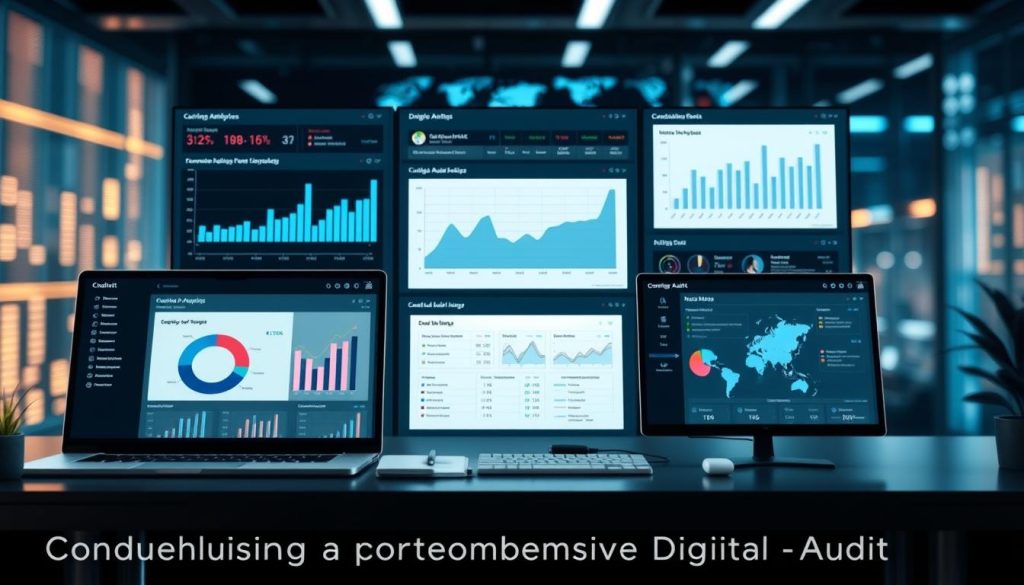Your company’s digital presence has never been more important. In today’s connected world, what people find when they search for your business can determine their trust and purchasing decisions.
This practice involves shaping how customers perceive your organization based on its digital footprint. It covers everything from search results to social media conversations and customer feedback.
Jason Mudd, CEO of Axia Public Relations, emphasizes that a proactive strategy is critical. « In competitive environments, reviews carry significant weight, » says Mudd. « A single negative comment can influence potential customers’ choices. »
A solid digital standing helps establish trust and attract clients. It directly drives revenue growth, making this effort a business imperative rather than just a marketing concern.
Table of Contents
Key Takeaways
- Your digital presence significantly impacts customer trust and business success
- Reputation management involves monitoring and shaping your company’s digital footprint
- Proactive strategies are essential in today’s review-driven environment
- Negative feedback can quickly influence potential customers’ decisions
- A strong digital reputation helps build trust and drive revenue growth
- This requires ongoing commitment rather than one-time projects
- Comprehensive planning includes auditing, strategy development, and crisis management
Understanding the Importance of Online Reputation Management
Modern businesses operate in an environment where digital impressions often precede physical interactions. What people find when searching for your company shapes their initial perception and influences their decisions.
Defining Online Reputation and Its Impact
Your digital footprint comprises all business activities that shape customer opinions. This includes search results, reviews on platforms like Google and Yelp, and social media conversations.
Research shows 43% of consumers turn to social networks when researching brands. Most people Google a company before engaging with it. This makes your digital presence crucial for forming positive first impressions.
Key Benefits for Brands and Businesses
Effective reputation management directly strengthens your brand image. It ensures positive information appears when people search for your business.
This approach helps establish trust with potential customers. In competitive markets, consumers have many options and can easily switch to competitors if they encounter negative associations.
A strong digital presence contributes to higher search rankings and customer acquisition. It also improves retention and drives measurable revenue growth. Implementing strategic approaches can transform how consumers perceive your organization.
| Business Area | Without Management | With Strategic Management |
|---|---|---|
| Customer Trust | Uncontrolled perceptions | Consistent positive image |
| Search Visibility | Mixed or negative results | Optimized positive content |
| Revenue Impact | Potential customer loss | Measurable growth |
| Competitive Position | Vulnerable to negatives | Strong market standing |
Conducting a Comprehensive Digital Audit
Before you can improve your brand’s digital standing, you must first understand where you currently stand. A comprehensive audit reveals what people are saying about your company and where these conversations happen.

This assessment uncovers both strengths to build upon and weaknesses needing attention. Start by examining your complete digital footprint across all platforms.
Assessing Your Current Online Presence
Begin with a simple manual search using an incognito browser. This provides unbiased results showing what potential customers see when searching your brand name.
Expand your analysis to include social media profiles, review sites, and industry forums. Look for patterns in customer sentiment across different channels. This data gives you a complete picture of your current brand perception.
Utilizing Social Listening and Analytics Tools
Advanced tools like Brandwatch Consumer Research automate the monitoring process. They scan millions of online sources for brand mentions, saving you hours of manual work.
These platforms consolidate all information into a single dashboard. You get a holistic view of your digital presence without searching every corner of the internet. Strategic approaches become clearer when you have all the data in one place.
Include competitor analysis in your audit. Understanding how similar brands manage their digital presence reveals industry best practices and opportunities for differentiation.
By the audit’s conclusion, you’ll clearly understand your brand’s position across positive, negative, and neutral mentions. This foundation supports all subsequent improvement efforts.
Crafting a Strategic Reputation Management Plan
Strategic planning transforms audit data into powerful brand protection. Your findings reveal what people truly think about your company. This information becomes the foundation for your improvement strategy.
Analyze your audit results to identify recurring themes. Look for patterns in both positive feedback and negative comments. This analysis helps you understand your current brand perception.
Identifying Key Strengths and Weaknesses
Conduct a SWOT analysis focused specifically on your digital presence. Identify competitive advantages you can leverage in your strategy. Also pinpoint vulnerabilities that need immediate attention.
Categorize issues by urgency and impact. Quick fixes address immediate problems affecting customer perception. Underlying issues may require deeper organizational changes.
Establishing Measurable Objectives and KPIs
Set clear, quantifiable goals for your improvement efforts. These objectives should align with your overall business strategy. Measurable targets keep your team focused and accountable.
Key performance indicators might include improved review ratings or faster response times. Tracking progress helps demonstrate the value of your reputation management strategy. Regular measurement ensures your plan remains effective over time.
Your comprehensive management strategy should include content creation and audience engagement. A proactive approach prevents problems before they escalate. This transforms your digital footprint into a business asset.
Creating Quality Content to Enhance Your Brand Image
Your content strategy directly shapes how customers perceive your business identity. High-quality materials establish trust and communicate your values effectively.

Think of your content as your company’s voice. If you don’t control this narrative, others will define it for you.
Content Strategies for SEO and Social Media Impact
Develop articles for your website that improve search engine optimization. Use relevant keywords naturally in titles and headings.
Create engaging social media posts that build audience connections. Interactive formats like videos and polls increase engagement significantly.
Aligning Content with Your Brand Identity
Ensure all materials reflect your brand‘s standards and values. Consistency across channels strengthens your image and builds recognition.
Your content should address themes identified during your audit. This strategic approach maximizes visibility and impact.
| Content Type | Primary Platform | Strategic Benefit |
|---|---|---|
| SEO Articles | Company Website | Improves search rankings |
| Social Media Posts | Social Platforms | Builds audience engagement |
| Press Releases | Earned Media | Secures positive coverage |
| Targeted Ads | Paid Channels | Controls brand perception |
Engaging with Your Audience Effectively
Today’s digital landscape demands more than just broadcasting messages—it requires genuine interaction with your community. Effective engagement transforms one-way communication into meaningful dialogue that builds trust.
Your audience expects authentic conversations, not just promotional content. This approach demonstrates that you value their input and perspectives.
Social Media Engagement Tactics
Successful social media strategies involve active participation beyond scheduled posts. Respond to comments, answer questions, and join relevant industry conversations.
Build community presence by engaging with followers’ content and contributing to ongoing narratives. This positions your brand as a valuable community member rather than just a business.
According to The 2025 Sprout Social Index™ Report, nearly 75% of consumers expect a response within 24 hours or less. Timely responses show you’re attentive to customer needs.
Responding to Reviews and Customer Feedback
Address every review your business receives, whether positive or negative. This demonstrates that you value customer feedback and are committed to improvement.
Thoughtful responses to criticism showcase your problem-solving abilities. Positive review engagement encourages more user-generated content and strengthens brand advocacy.
Balance automation with human touch in your interaction approach. While AI can handle initial inquiries, important conversations require genuine human connection.
Every social media interaction represents an opportunity to reinforce positive perceptions. A comprehensive engagement strategy ensures consistent, meaningful connections with your audience across all platforms.
Managing Negative Reviews and Crisis Situations
Every business will eventually face customer dissatisfaction and negative feedback. Ignoring these situations only worsens the problem. Your brand’s true character emerges during challenging moments.
What defines your company isn’t the criticism itself but how you handle it. Professional responses to one-star reviews or critical comments demonstrate genuine customer care.
Appropriate Responses to Negative Feedback
Develop a systematic approach for handling negative reviews. Always respond calmly and professionally, even when you disagree with the feedback.
Jason Mudd advises, « Apologize if warranted, address the issue constructively and invite the customer to discuss their concerns offline to resolve them directly. » This approach shows commitment without public escalation.
Take conversations offline for sensitive matters or to prevent wider visibility. Proper handling often transforms critics into brand advocates who appreciate your responsiveness.
Implementing a Crisis Management Plan
Prepare for larger crisis situations before they occur. Monitoring tools like Brandwatch can detect emerging problems early.
Jay Egger notes that « any press is good press » rarely holds true. Successful crisis management requires implementing real changes and honest communication with your audience.
A comprehensive plan should include escalation protocols and response templates. Avoid defensive reactions and « no comment » responses, which damage credibility.
Effective crisis management protects your brand during challenging situations while demonstrating your commitment to improvement.
Amplifying Positive Coverage and Testimonials
While addressing negative feedback is crucial, actively promoting positive customer experiences creates powerful momentum for your brand. Positive reviews and success stories serve as authentic social proof that validates potential buyers’ decisions.
This approach creates a chorus of praise that naturally drowns out negative noise. The strategic promotion of favorable coverage makes your marketing content more believable when backed by independent advocacy.
Leveraging User-Generated Content and Success Stories
Showcasing authentic testimonials provides the most credible demonstration of your impact. Encourage satisfied clients to share their experiences through simple prompts and recognition.
User-generated materials like social media posts and video stories create genuine connections. This content often resonates more deeply than corporate messaging.
A systematic approach to collecting positive reviews establishes a virtuous cycle. Great service leads to favorable feedback, which attracts more customers and generates additional positive coverage.
Request testimonials immediately after positive experiences. Make the process convenient and consider small incentives to encourage participation. This consistent stream of authentic praise continuously strengthens your brand‘s position.
Ongoing Monitoring and Maintenance Strategies
Maintaining your brand’s digital health requires constant vigilance and regular check-ups. This continuous approach ensures your digital presence remains strong over time.
Think of it like maintaining physical fitness. The initial workout gets you started, but consistency keeps you in shape.
Setting Up Real-Time Alerts and Notifications
Configure monitoring tools like Brandwatch Consumer Research for immediate alerts. These systems notify you when your brand appears anywhere online.
Google Alerts provides basic coverage for brand names and key terms. Comprehensive social listening platforms offer deeper analysis across multiple channels.

Analyzing Sentiment and Tracking Key Metrics
Sentiment analysis reveals whether mentions are positive, negative, or neutral. This tracking helps identify service gaps and improvement opportunities.
Monitor essential metrics including review ratings and response times. These indicators show whether your reputation is strengthening or declining.
| Monitoring Approach | Primary Function | Best For |
|---|---|---|
| Real-Time Alerts | Immediate notification | Crisis prevention |
| Sentiment Analysis | Emotional tone assessment | Brand perception tracking |
| Performance Metrics | Quantitative measurement | Strategy refinement |
Continuous monitoring serves dual purposes. It catches problems early and identifies positive stories to amplify.
Your findings should feed back into strategy improvements over time. This creates a cycle of constant enhancement for your digital presence.
Utilizing Advanced Tools and Software for Online Reputation Management
Without the right technological support, even the most diligent teams can miss critical conversations shaping public perception. The digital landscape’s vastness demands specialized software that aggregates data across multiple platforms.
Essential Features to Look for in Reputation Management Tools
Effective tools should consolidate mentions from social networks and review sites into unified dashboards. This comprehensive approach ensures no important conversation goes unnoticed.
Look for software with collaborative workspaces that allow cross-team coordination. Scalability is another crucial feature, as digital platforms constantly evolve their features.
| Feature Category | Basic Tools | Advanced Solutions |
|---|---|---|
| Channel Integration | Limited platforms | Comprehensive coverage |
| Reporting Capabilities | Basic metrics | Trend analysis & ROI tracking |
| Collaboration Features | Single-user focused | Multi-team workspace |
| Scalability | Fixed functionality | Adapts to platform changes |
Integrating AI and Automation for Efficiency
AI technology revolutionizes how businesses handle digital conversations. Intelligent systems can prioritize urgent mentions and automate routine responses.
This automation significantly improves response times and operational efficiency. Advanced AI can even predict emerging issues before they escalate.
Platforms like Sprout Social demonstrate how automation transforms digital oversight. They aggregate brand mentions across numerous channels, allowing teams to focus on strategic analysis rather than manual monitoring.
Exploring Future Trends in Online Reputation Management
The digital landscape continues to shift rapidly, requiring brands to anticipate emerging trends rather than simply react to current conditions. Companies must adapt their approaches to remain effective in this changing environment.
Evolving Role of Social Media and Digital Channels
Social platforms have effectively become the new search engines where brand perception is built in real-time. According to GWI research, 43% of consumers across all ages turn to social networks when researching brands.
Platforms like Reddit, TikTok and X have become critical destinations for investors conducting due diligence. This makes maintaining a strong presence increasingly important for investor relations.

Businesses must engage customers where they’re most active across emerging channels. Positioning your brand as a reliable industry expert builds lasting advantages in competitive markets.
Impact of Emerging Technologies and AI Innovations
By 2026, companies must consider how their brand appears in AI-powered searches like ChatGPT and Gemini. These conversational platforms represent a significant shift from traditional search.
AI innovations are changing digital presence management itself. Advanced sentiment analysis and predictive analytics become standard features that companies must leverage.
| Future Trend | Current Approach | 2026 Requirement |
|---|---|---|
| Search Behavior | Google-focused | Multi-platform AI search |
| Content Format | Text and images | Video and interactive |
| Response Time | 24-hour standard | Instant personalized |
| Technology Use | Basic monitoring | AI-powered prediction |
Staying ahead requires continuous learning and investment in new technologies. Companies that fail to adapt risk losing relevance with consumers who increasingly live their digital lives on new platforms.
Conclusion
In today’s interconnected marketplace, your brand’s digital footprint serves as its permanent public record. You truly don’t get a second chance to make that critical first impression.
A strong reputation management strategy protects your business from digital threats while attracting new customers. It deepens relationships with existing clients and builds lasting trust.
Remember that your online presence creates real-world business outcomes. The comprehensive approach we’ve outlined—from audits to ongoing monitoring—ensures your digital assets work for you rather than against you.
This isn’t a one-time project but an ongoing commitment to excellence. Consistent attention and adaptation to changing digital landscapes are essential for long-term success.
Begin your reputation management journey today by conducting that first crucial audit. Waiting until a crisis emerges is too late to build the foundation needed for effective brand protection.
FAQ
What is the primary goal of managing a brand’s digital presence?
The main goal is to shape and control the public perception of a brand across digital channels. This involves promoting positive content, addressing concerns, and building trust with your audience to protect and enhance your brand image.
How often should I check my business’s social media and review sites?
It’s best to monitor your social media channels and review platforms like Google My Business and Yelp daily. Setting up real-time alerts using tools like Google Alerts or Brand24 can help you stay on top of new mentions and feedback instantly.
What is the best way to handle a negative review?
Respond promptly, professionally, and empathetically. Acknowledge the customer’s concern, apologize if appropriate, and offer to resolve the issue privately. This shows other potential customers that you value feedback and are committed to service quality.
Can positive customer testimonials really influence my business?
Absolutely. Positive reviews and user-generated content, like customer photos or success stories, serve as powerful social proof. Sharing these testimonials on your website and social channels can significantly boost credibility and attract new consumers.
What are some key metrics to track for my brand’s digital health?
Important metrics include overall sentiment analysis (positive, negative, neutral), review ratings, engagement rates on social posts, share of voice compared to competitors, and the visibility of your brand in search engine results.
How does content creation help with my brand’s image?
Creating high-quality, relevant content that aligns with your brand identity helps push positive information to the top of search results. This strategy improves SEO, engages your audience, and establishes your company as an authority in your field.
What should be included in a crisis management plan?
A solid plan should include a designated response team, pre-approved messaging templates for different scenarios, clear communication channels, and a protocol for rapid response to minimize damage and control the narrative during a crisis.





